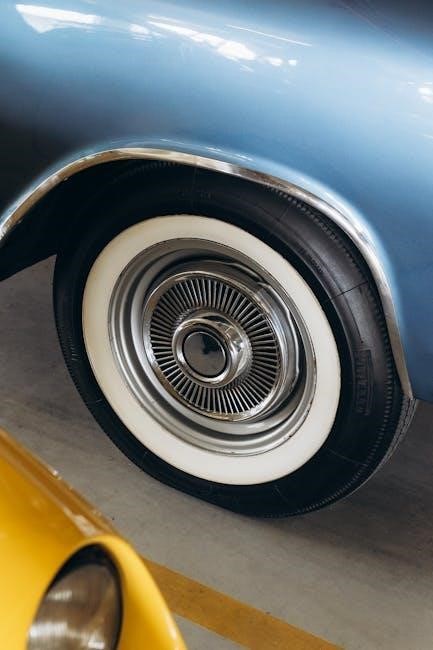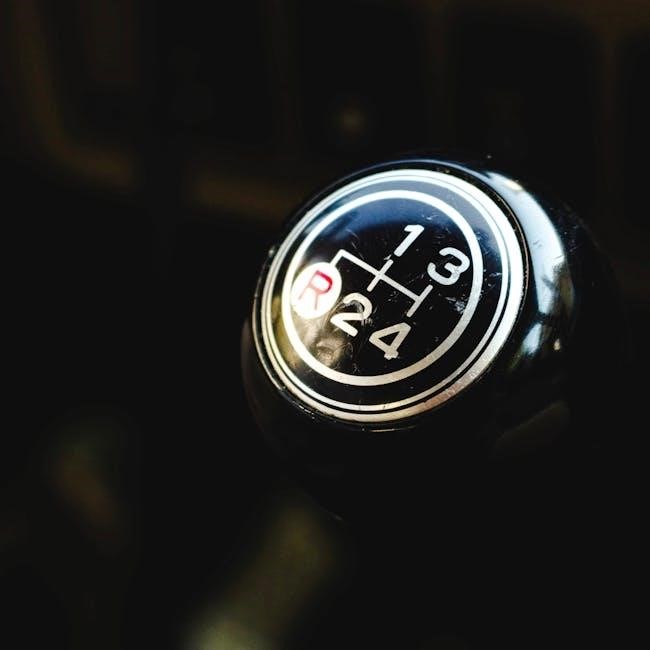Car manuals are crucial guides providing detailed information about vehicle operation, maintenance, and repair. They are typically created by car manufacturers, engineering teams, technical writers, and third-party contributors, ensuring accuracy and accessibility for users.

Overview of Car Manuals
Car manuals are essential resources that provide detailed information about vehicle operation, maintenance, and repair. They serve as comprehensive guides, helping users understand their cars’ features, troubleshooting tips, and repair procedures. These manuals are typically divided into sections, covering topics such as engine specifications, safety precautions, and diagnostic tools. They are designed to be user-friendly, ensuring that both novice and experienced drivers can navigate the content easily. Car manuals are often available in both physical and digital formats, with digital versions offering searchable content for quick access. Additionally, they may include visual aids like diagrams and illustrations to clarify complex processes. Overall, car manuals are indispensable for car owners, offering insights that help extend the vehicle’s lifespan and ensure optimal performance.
Importance of Car Manuals
Car manuals are vital resources for vehicle owners, providing essential information to ensure safe and efficient operation. They serve as a bridge between the manufacturer and the user, offering detailed insights into maintenance, troubleshooting, and repair processes. By following the guidelines in a car manual, drivers can prevent potential errors, reduce risks of accidents, and extend the lifespan of their vehicle. These manuals also empower users to perform routine checks and minor repairs, saving time and money. Additionally, they provide clarity on complex technical aspects, making them indispensable for both novice and experienced drivers. Whether for understanding safety features, optimizing fuel efficiency, or addressing mechanical issues, car manuals are a cornerstone of responsible vehicle ownership. Their importance lies in their ability to demystify car care, fostering confidence and independence among drivers.
Objective of the Article
This article aims to provide a comprehensive understanding of car manuals, focusing on their creation, content, and significance. It explores the collaborative efforts behind these manuals, highlighting the roles of manufacturers, technical writers, engineers, and third-party contributors. By examining the expertise and resources involved, the article sheds light on how manuals ensure accuracy, safety, and user accessibility. The objective is to inform readers about the meticulous process of compiling such guides, emphasizing their importance for vehicle owners and enthusiasts. Additionally, it seeks to clarify how these manuals serve as a bridge between technical complexity and user-friendly information, making them an indispensable tool for maintaining and understanding modern vehicles. Through this exploration, the article aims to enhance appreciation for the precision and care that goes into creating these essential resources.

The Role of Car Manufacturers
Car manufacturers oversee the creation of manuals, ensuring they are accurate and user-friendly. They compile engineering data, testing insights, and regulatory requirements to produce guides that meet safety and quality standards.
Engineering Teams
Engineering teams play a vital role in car manual creation by providing detailed technical specifications and data. They ensure the manual accurately reflects the vehicle’s design, performance, and safety features. These teams gather information from development, testing, and quality assurance processes, ensuring the manual is comprehensive and reliable. Their expertise guarantees that the instructions are clear and aligned with the manufacturer’s standards, making the manual an indispensable resource for drivers and technicians alike.
Technical Writers
Technical writers are instrumental in transforming complex engineering data into clear, accessible content for car manuals. They collaborate with engineering teams to extract precise technical specifications, ensuring the information is accurate and understandable. These professionals specialize in organizing data into structured, user-friendly formats, making it easier for drivers and technicians to follow instructions. Technical writers use clear, concise language to explain maintenance procedures, troubleshooting tips, and safety guidelines. They also incorporate visual aids like diagrams and charts to enhance comprehension. By bridging the gap between technical expertise and end-user needs, technical writers play a crucial role in making car manuals informative and practical. Their work ensures that users can confidently perform routine maintenance, understand safety features, and address common issues effectively, making them indispensable contributors to the creation of car manuals.
Quality Assurance Teams
Quality assurance (QA) teams are essential in ensuring the accuracy and reliability of car manuals. Their primary role involves reviewing and validating the content to ensure it meets industry standards and regulatory requirements. QA teams conduct thorough audits of the manual, checking for technical errors, inconsistencies, and clarity. They also verify that all safety guidelines and legal disclaimers are appropriately included. By implementing rigorous testing and feedback loops, QA teams help identify and correct any discrepancies before the manual is finalized. Their attention to detail ensures that users receive a comprehensive and trustworthy guide, free from ambiguity. The involvement of QA teams significantly enhances the overall quality of car manuals, making them more user-friendly and reliable for drivers and technicians alike. Their work is crucial in maintaining the integrity and effectiveness of the manual as a vital resource for vehicle ownership and maintenance.

Design Teams
Design teams play a pivotal role in shaping the visual and structural aspects of car manuals. They are responsible for creating layouts, illustrations, and graphics that enhance the manual’s clarity and readability. Using advanced design tools, these teams ensure that complex technical information is presented in an intuitive and visually appealing manner. They collaborate closely with technical writers and engineering teams to align the design with the content’s intent. Design teams also focus on branding, ensuring that the manual reflects the car manufacturer’s identity. Their work includes developing infographics, flowcharts, and diagrams to simplify maintenance and repair instructions. By prioritizing user experience, design teams make the manual accessible to a broad audience, from novice drivers to experienced technicians. Their contribution is instrumental in transforming raw technical data into a coherent, visually engaging guide that aids in understanding and troubleshooting vehicle operations effectively. Their efforts ensure the manual is both informative and aesthetically pleasing, enhancing overall user satisfaction.

Third-Party Contributions
Third-party contributors, such as freelance technical writers, publishing companies, translation services, and digital platform providers, play a significant role in creating and distributing car manuals, ensuring they are accurate, accessible, and widely available.
Freelance Technical Writers
Freelance technical writers play a vital role in creating car manuals by converting complex engineering data into clear, user-friendly content. They often collaborate with manufacturers to ensure accuracy and accessibility. These writers specialize in breaking down technical jargon, making manuals understandable for all drivers. Freelancers also contribute by updating manuals with the latest features and troubleshooting guides. Their work ensures that drivers can easily navigate maintenance, repair, and operational instructions. Additionally, freelance writers may translate manuals into multiple languages, expanding their reach globally. Their flexibility allows manufacturers to scale content creation without relying solely on in-house teams. By leveraging their expertise, freelance technical writers enhance the overall quality and clarity of car manuals, making them indispensable resources for vehicle owners worldwide.
Publishing Companies
Publishing companies specializing in automotive literature play a significant role in producing car manuals. They often collaborate with manufacturers and third-party writers to create detailed guides. Companies like Haynes and Chilton are well-known for their comprehensive manuals, offering step-by-step instructions for maintenance, repair, and troubleshooting. These publications cater to both DIY enthusiasts and professional mechanics. Publishing companies ensure manuals are accessible in various formats, including print and digital versions. They also handle translations, making manuals available in multiple languages. By adhering to industry standards, these companies guarantee accuracy and clarity. Their work bridges the gap between technical expertise and user-friendly content, ensuring drivers and technicians can rely on the information provided. Publishing companies are essential in making car manuals widely available and understandable for diverse audiences worldwide.
Translation Services
Translation services are vital in creating car manuals for global audiences. These services ensure that technical content is accurately translated into multiple languages, maintaining the original meaning and clarity. Specialized translators with expertise in automotive terminology collaborate with technical writers to adapt manuals for different regions. Cultural nuances and regional specifications are carefully considered to make the content relevant and accessible. Translation services also handle localization, ensuring compliance with local regulations and standards. By providing manuals in various languages, manufacturers can reach a broader market, enhancing customer satisfaction. Digital tools and AI-driven platforms often assist in streamlining the translation process, ensuring consistency and efficiency. The role of translation services is crucial in making car manuals universally understandable, bridging language barriers, and supporting manufacturers’ global distribution strategies. Their work ensures that users worldwide can benefit from clear, accurate, and culturally adapted instructions for their vehicles.
Digital Platform Providers
Digital platform providers play a significant role in the creation and distribution of car manuals by offering innovative solutions for hosting, organizing, and accessing technical content. These platforms enable manufacturers to publish manuals in digital formats, making them easily accessible to users worldwide. They often integrate advanced search functions, voice search capabilities, and mobile-friendly designs to enhance user experience. Digital platforms also support the distribution of manuals in multiple languages, ensuring global accessibility. Some platforms specialize in cloud-based storage, allowing users to access manuals anytime, anywhere. Additionally, they may provide tools for interactive content, such as videos and 3D models, to complement traditional text-based instructions. By leveraging these digital solutions, manufacturers can ensure that car manuals are not only convenient but also engaging and user-friendly. This collaboration between manufacturers and digital platforms has revolutionized how car manuals are delivered to consumers, making them more accessible and efficient than ever before.

Expert Input
Expert input in car manuals is provided by automotive engineers, industry consultants, and test drivers, ensuring technical accuracy, practical insights, and real-world applications for drivers and technicians alike.
Automotive Engineers
Automotive engineers play a pivotal role in the creation of car manuals by providing detailed technical insights and specifications. Their expertise ensures that the information is accurate, up-to-date, and aligned with the vehicle’s design and functionality. Engineers typically oversee the development of sections related to diagnostics, troubleshooting, and maintenance procedures. They collaborate closely with technical writers to translate complex mechanical concepts into clear, accessible language. Additionally, automotive engineers review and validate the content to ensure it meets safety and regulatory standards. Their input is essential for both drivers seeking routine maintenance guidance and technicians performing advanced repairs. By combining hands-on experience with theoretical knowledge, automotive engineers ensure that car manuals are comprehensive and reliable resources for all users.
Industry Consultants
Industry consultants are specialized professionals who contribute to the development of car manuals by offering expertise in automotive trends, regulations, and user needs. They often collaborate with manufacturing teams and technical writers to ensure the content is both accurate and user-friendly. Consultants may analyze market trends to identify common issues drivers face, ensuring the manual addresses these concerns. Their input helps in structuring the information logically, making it easier for readers to navigate. Additionally, industry consultants may review the manual for compliance with industry standards and legal requirements. Their role is crucial in bridging the gap between technical details and real-world applicability, ensuring the manual is a valuable resource for both novice drivers and experienced technicians. By integrating their insights, consultants enhance the overall quality and relevance of the car manual.
Test Drivers
Test drivers play a pivotal role in the creation of car manuals by providing real-world insights into vehicle performance and usability; Their hands-on experience helps identify potential issues and areas for improvement in the manual. By driving various prototypes and production vehicles under different conditions, test drivers gather data that shapes the content of the manual, ensuring it reflects real user experiences. Their feedback is instrumental in refining instructions, troubleshooting sections, and maintenance recommendations. Test drivers often collaborate with technical writers and engineers to translate their findings into clear, actionable guidance for car owners. This collaboration ensures that the manual is both comprehensive and practical, addressing common concerns and enhancing the overall driving experience. Their contributions are essential in making car manuals user-friendly and reliable, serving as a bridge between manufacturer specifications and real-world application.

Legal Considerations
Legal considerations in car manuals involve compliance specialists, liability lawyers, and regulatory affairs experts. They ensure content adheres to laws and industry standards, minimizing risks and protecting both manufacturers and users.
Compliance Specialists
Compliance specialists play a vital role in ensuring that car manuals adhere to legal and regulatory standards. They review the content to verify accuracy and compliance with industry guidelines, ensuring that all information is presented clearly and correctly. These professionals work closely with legal teams to identify potential risks and ensure that the manual meets all necessary safety and environmental regulations. They also oversee the inclusion of required disclaimers and warnings, protecting both the manufacturer and the user from legal liabilities. Additionally, compliance specialists handle translations and regional adaptations, ensuring that manuals comply with local laws and standards in different markets. Their attention to detail and expertise in regulatory affairs are crucial in maintaining the integrity and legal standing of the manual, ultimately safeguarding the manufacturer’s reputation and ensuring user safety.
Liability Lawyers
Liability lawyers play a critical role in shaping the content of car manuals to protect manufacturers from potential legal claims. They ensure that the manual is clear, accurate, and free from ambiguities that could lead to misinterpretation. These legal experts review the language and instructions to minimize risks associated with user errors or misunderstandings. They also verify that all safety precautions and warnings are prominently displayed, reducing the likelihood of liability issues. Liability lawyers collaborate with compliance specialists to ensure that the manual aligns with legal standards and industry regulations. Their input is essential in drafting disclaimers and limitations of liability, safeguarding the manufacturer’s interests. By addressing legal vulnerabilities, liability lawyers help create a manual that not only informs users but also protects the company from potential lawsuits. Their work is instrumental in maintaining the balance between user guidance and legal protection.
Regulatory Affairs Experts
Regulatory affairs experts are instrumental in ensuring that car manuals comply with legal and industry standards. They work closely with compliance specialists and legal teams to review the content of manuals, guaranteeing adherence to safety regulations, emissions standards, and other legal requirements; These experts ensure that all information provided in the manual aligns with governmental and industry guidelines, reducing the risk of non-compliance. They also verify that safety warnings and operational instructions are clear and meet regulatory expectations. By maintaining compliance, regulatory affairs experts help protect both the manufacturer and the user from potential legal issues. Their expertise ensures that the manual is not only informative but also legally sound, fostering trust and reliability in the vehicle’s operation. Their role is pivotal in balancing technical accuracy with regulatory demands, ensuring the manual serves as a comprehensive and compliant resource for drivers.

Modern Innovations
AI tools and machine learning engineers are revolutionizing car manuals by enhancing clarity and accessibility through intelligent content generation and personalized user experiences.
AI Tools
AI tools are increasingly being utilized in the creation and enhancement of car manuals, offering advanced solutions for content generation, personalization, and accessibility. These tools leverage machine learning algorithms to analyze vast datasets, ensuring manuals are accurate, up-to-date, and tailored to specific vehicle models. AI-powered systems can automatically generate step-by-step instructions, diagrams, and troubleshooting guides, reducing the need for manual writing. Additionally, AI-driven platforms enable real-time updates, ensuring users always have the latest information. Voice search and interactive features are also being integrated, making manuals more user-friendly. AI tools not only streamline the production process but also improve the overall quality and relevance of car manuals, catering to the evolving needs of drivers and technicians alike. This innovative approach ensures that car manuals remain a vital resource in the digital age, bridging the gap between traditional documentation and modern technology.

Machine Learning Engineers
Machine learning engineers play a pivotal role in shaping the future of car manuals by integrating advanced technologies into their creation. These experts develop algorithms and models that analyze vast datasets, enabling the automation of content generation, such as step-by-step instructions and diagnostic guides. By leveraging natural language processing (NLP), machine learning engineers improve the clarity and accessibility of manuals, making complex information easier to understand. They also work on personalization features, tailoring manuals to specific user needs and vehicle models. Collaborating with technical writers, engineers ensure that the content is both accurate and engaging. Their work extends to enhancing user experience through smart search functions and interactive elements. Additionally, machine learning engineers contribute to real-time updates, ensuring manuals stay current with the latest technological advancements. Their innovative contributions are transforming car manuals into dynamic, intelligent resources that cater to the demands of modern drivers and technicians, ensuring optimal user satisfaction and efficiency.

Future Trends
Future car manuals will leverage AI tools and augmented reality integration, offering immersive, interactive experiences. Collaboration between engineers and writers will ensure manuals are dynamic, user-centric, and continuously updated for emerging technologies.
Augmented Reality Integration
Augmented reality (AR) is revolutionizing car manuals by enhancing user experience through immersive, interactive guides. AR integration allows users to visualize complex repair and maintenance tasks in real-time, overlaying digital instructions onto physical vehicles. This technology bridges the gap between physical and digital spaces, making manuals more accessible and intuitive. By scanning a vehicle or specific components, users can access step-by-step AR tutorials, reducing confusion and improving accuracy. Engineering teams and technical writers collaborate to create precise AR content, while design teams ensure seamless integration with existing platforms. Machine learning engineers optimize AR systems for responsiveness and clarity. As AR becomes mainstream, car manuals will evolve into dynamic, interactive tools, empowering users with cutting-edge technology. This innovation not only enhances understanding but also reduces errors, making DIY repairs and maintenance more achievable for car owners worldwide. The future of car manuals lies in this blend of tradition and technological advancement.
Global Collaboration
Global collaboration has become a cornerstone in the creation of modern car manuals, fostering innovation and efficiency; Manufacturers, technical writers, and experts from diverse regions contribute to these manuals, ensuring they meet universal standards while addressing regional specifics. This collaborative approach allows for the sharing of knowledge and resources, enriching the content with varied perspectives. Translation services and digital platforms facilitate seamless teamwork, enabling real-time contributions from stakeholders worldwide. By pooling expertise, global teams produce manuals that are not only comprehensive but also adaptable to different markets. This synergy ensures that users receive accurate, relevant, and accessible information, regardless of their location. Global collaboration enhances the quality and accessibility of car manuals, making them indispensable tools for drivers and technicians alike. It also promotes consistency and reduces errors, ensuring that the final product is reliable and user-friendly. This trend underscores the importance of teamwork in the digital age, shaping the future of automotive documentation.
